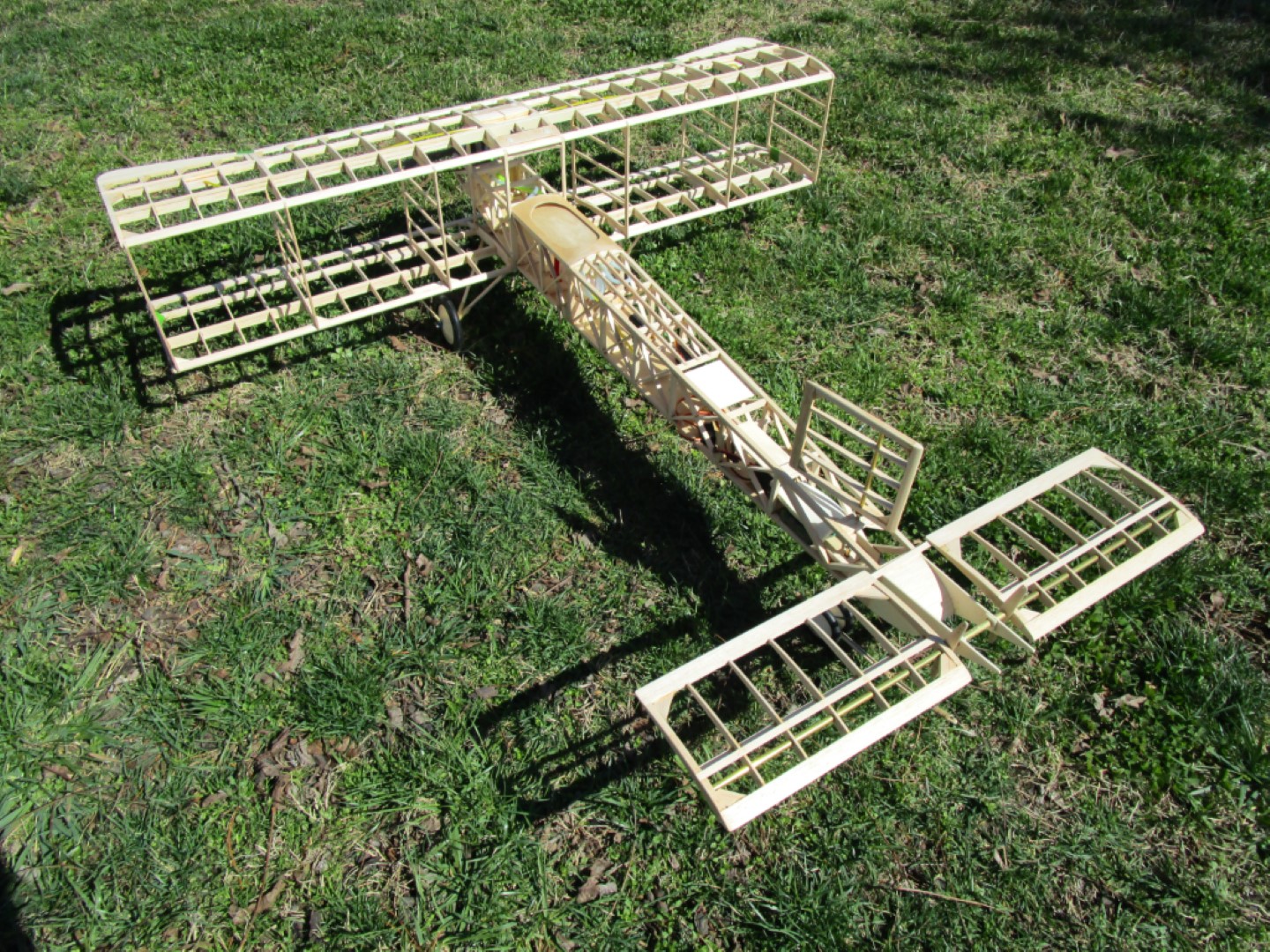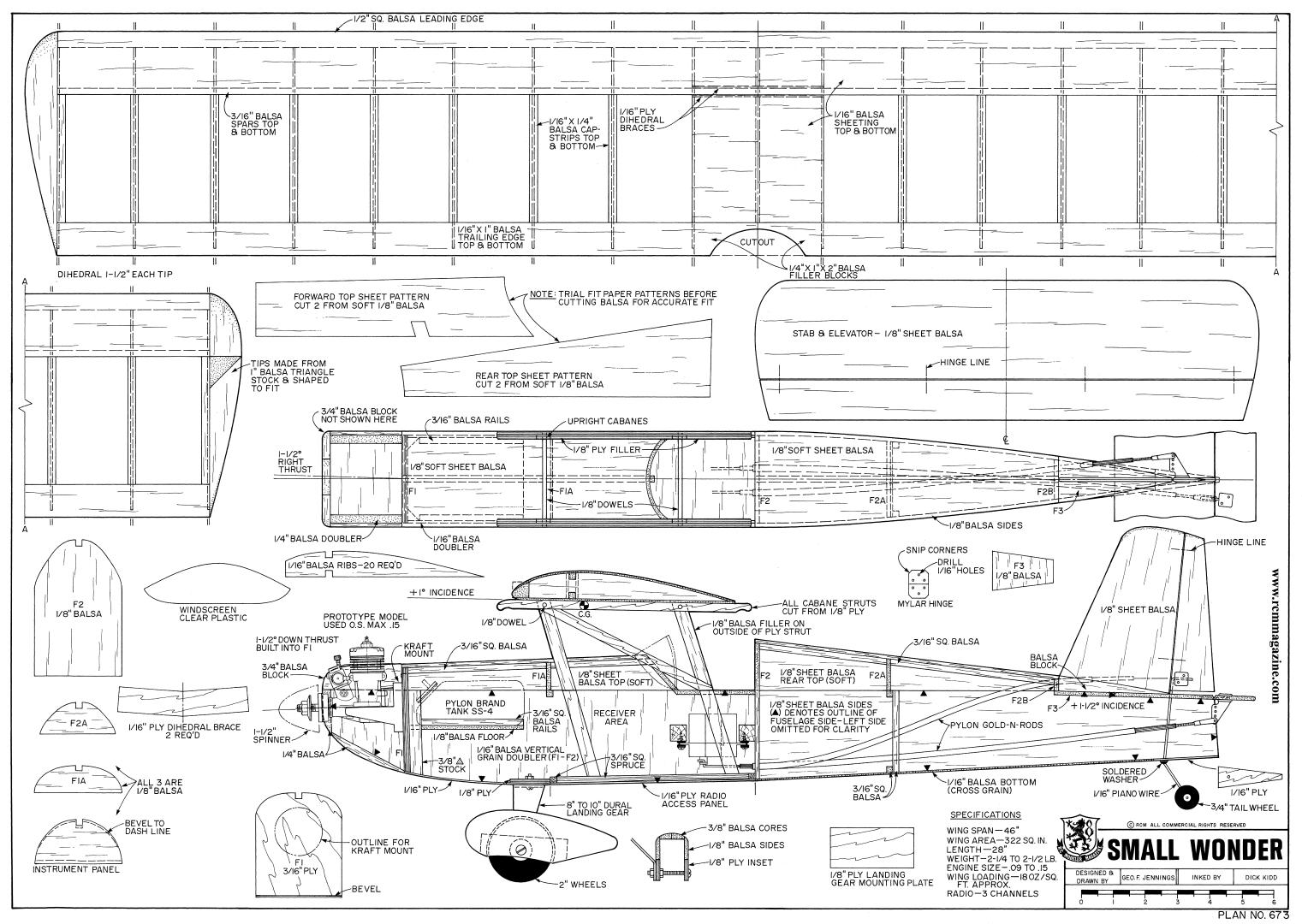For visitors to my website, my “Build of the Month” (BOTM) Series was created to help those who are trying to get started in building their own Radio Controlled (RC) Model Aircraft.
"Aerofred.com" and "Outerzone.co.uk" are two of my favorite web sites to obtain free RC model airplane plans for my new builds. Additionally, they like to post images of Builder's models, and both sites have posted my RC model images and build descriptions under the heading of the associated aircraft model. Other good sources for free plans are: "Hip Pocket Aeronautics Builders' Plan Gallery", "Vintage & Old-Timer RCM Free Plans", "James Hatton Blog Free Plans and Articles", "Hlsat Blog RCModeler Free Plans and Articles", and "Don Dewey Memorial RCM Plans Collection."
If you are currently not an active builder, and you would like to be, my BOTM Series is a great place to start. If you have an RC model aircraft that you would like to see featured in this section or feel others may find interesting, please let me know and I will make every attempt to find scratch build plans, photos, and maybe even a published build article, which I will then post in one of my future BOTM editions. Just send me an email @: Build of the Month.
All prior “BOTM” Editions are now available for your viewing pleasure @:
BOTM Series 2023 Archive
BOTM Series 2024 Archive
BOTM Series 2025 Archive
NOTE - You can view all images in a “Spotlight Box” by simply clicking on any image.
Build of the Month Series - June 2025 Edition
I hope you enjoyed last months BOTM WW-II Mini-Series 8th Edition on the Junkers Ju-87 RC model. If you have an RC model that you would like to see featured in this section or feel others may find interesting, please let me know and I will make every attempt to find scratch build plans, photos, and maybe even a published build article, which will then post in a future edition. Just send me an email @: Build of the Month.
Ok, now lets see what I have for the month of June 2025. Since the main purpose of my BOTM Series is to help newcomers to the hobby of RC flying, I'm going to end the WW-II Mini-Series for now and move back to something that is not only easy to build, but fun to fly and is economical. So given these requirements, this month features the RCModeler's Small Wonder, another classic design by George F. Jennings.
Images Source: Outerzone Small Wonder Webpage.
Please note - Much of the following description was extracted or paraphrased from an article written by George F. Jennings, and published in the January 1977 issue of RCModeler's Magazine.
The Small Wonder is a fun airplane. You can relax, have a ball, and fly as much as you like on a minimum investment with this RC model airplane. I have always liked the look of a parasol airplane. Some of my best memories of RC flying go back some 25+ years to when I built and flew my first parasol, a Great Planes Pete-n-Poke. The Pete-n-Poke was a great flyer and gave me my first taste of true success in the form of consistent flight performance.
The George F. Jennings Small Wonder is an effort to duplicate the fun and relaxed flying he had with his first parasol RC model, a Petite Parasol, except with a modern home-built flair added. Stolp Starlet, Baby Ace, and Pober Pixie are all examples of modern day parasol designs that have become popular with the Experimental Aircraft Association (EAA) members everywhere. The Small Wonder is a scale-like airplane that could very easily have a full-size counterpart hiding in some EAA'ers garage.
With 320 square inches of wing area, a three channel radio, an O.S. .15 2-stroke RC engine, and a healthy epoxy paint finish, the flying weight is approximately 40 ounces. This results in a wing loading of 18.0 oz. per sq. ft. and is right in the ballpark for a first time RC flyer. If you want a real floater, use an .09 engine, and cover with Solarfilm or similar light weight heat shrink covering, and it should weigh-in at 36 ounces, or less!
Building a Small Wonder is easy, quick, and economical. With a flat bottom wing (using twenty identical cut 1/16″ balsa sheet ribs) that you can build directly over your wax paper covered plan, 1/8″ balsa sheet fuselage and vertical/horizontal stabilizers, and minimal fuselage formers all make this RC model is an excellent choice for a first time scratch build. If desired, a conversion to electric power should not be difficult given the radio compartment hatch on the bottom of the fuselage is held in place with screws. This is a definite plus.
One recommended modification is to make the fuel tank floor removable. This is done in order to remove the tank after construction in case of a problem. A triangle shaped shelf can be added to the rear of the firewall. The tank floor then sits on top of the triangle and is held up in place by foam around the battery pack. Don't let the curved fuselage top and cabane struts throw you. George has engineered out the hard part. The 8 pages of building instructions in the RCModeler's article are very easy to follow along with being complete, and have several pictures to aid in the build. They are written so that as each step is finished, that step can be checked off. This method, if followed, should keep you from building any part out of sequence. Just follow the steps in the RCModeler's article and in a few evenings you too will have a very nice parasol model that will provide you with many hours of fun and relaxed flying.
In the flight performance department the Small Wonder excels. Take-offs are effortless and require very little rudder correction. Lift-off is smooth with no zoom and, once airborne, this RC model is rock solid and goes where you point her. With an .09 engine in the nose, flight is slow and relaxed; however, a .15 provides enough zing to really tear up the sky. You may even be able to invent some aerobatic maneuvers of your own! Landings are easy with good control all the way in, and once back on the ground you will be delighted with the ground handling. It is truly a Small Wonder!
- Small Wonder Specifications:
- Aircraft Type: Sport Trainer
- Wing Span: 46″
- Wing Chord: 7″
- Total Wing Area: 320 square inches
- Wing Location: Parasol Wing
- Airfoil: Flat Bottom
- Wing Platform: Constant Chord
- Dihedral @ each Wingtip: 1.5″
- Fuselage Length: 28″
- Stabilizer Span: 15.75″
- Stabilizer Chord: 4.375″
- Stabilizer Area: 65.5 square inches″
- Stab Airfoil Section: Flat
- Vertical Fin Height: 5″
- Vertical Fin Width (incl. rudder): 3.75″ average
- Rec. No. of Channels: 3 - Throttle, Rudder, and Elevator
- Fuel Tank Size: 4 oz.
- Landing Gear: Conventional Tail Dragger
- Ready to Fly Weight: 36 - 40 oz. depending on power system selection
- Glow Fuel Engines: .09 - .15 2-stroke
- Electric Powered: Output of 200 - 300 Watts, 30 - 40 Amp ESC, 3 cell 45C LiPo pack of 1,500 - 2,200mah.
The RCModeler's Small Wonder RC model in this months edition can be built using the RCM Plan #673 and RCM article available at AeroFred.com and Outerzone.co.uk Websites.
AeroFred Small Wonder Webpage
Outerzone Small Wonder Webpage
I hope you have enjoyed this months selection, and just maybe, I have spurred some interest in trying your hand at building an RC model airplane.
Until next month - Keep the Balsa Dust Flying!!





 All HTML & CSS Coded by Larry
All HTML & CSS Coded by Larry